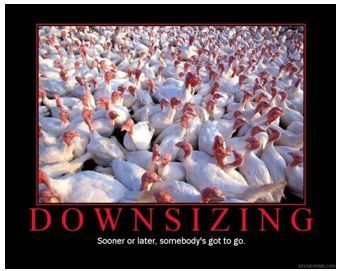
Many hedge fund traders are unhappy about the current near monopoly enjoyed by the top three ETF issuers, Black Rock, State Street, and Vanguard, which control 80% of the market. At last count more than 1,300 ETF?s were capitalized at more than $1.4 trillion. The result has been grasping management fees, exorbitant expense ratios, and poor structural designs, which create massive tracking error.
The good news is that new entrants are flooding into the ETF space, and the heightened competition they are bringing will help curtail the worst of these abuses. This development will accelerate the demise of the bloated and arthritic mutual fund industry, whose end has been a long time in coming. Not only will management fees and expense ratios plunge, there will be a far broader range of offerings, as new funds are launched from a diverse range of institutions coming from differing areas of expertise. Failure to enter the newly lucrative ETF market by the remaining giants sitting on the sidelines means that their existing mutual fund businesses will be cannibalized.
Look no further than bond giant PIMCO, which CAME out with a plethora of fixed income related funds, Van Eck?s expanding list of ETF?s for commodities, and the even growing list of inverse and leveraged inverse ETF?s presented by ProShares. The bottom line will be that lower costs and tighter spreads will leave more profits on the table for the rest of us.
The Mutual Fund Industry is Getting Cannibalized
A few years ago, I went to a charity fund raiser at San Francisco?s priciest jewelry store, Shreve & Co., where the well-heeled men bid for dates with the local high society beauties, dripping in diamonds and Channel No. 5. Well fueled with champagne, I jumped into a spirited bidding war over one of the Bay Area?s premier hotties, who shall remain nameless. Suffice to say, she has a sports stadium named after her.
The bids soared to $10,000, $11,000, $12,000. After all, it was for a good cause. But when it hit $12,400, I suddenly developed lockjaw. Later, the sheepish winner with a severe case of buyer?s remorse came to me and offered his date back to me for $12,000.? I said ?no thanks.? $11,000, $10,000, $9,000? I passed.
The current altitude of the stock market reminds me of that evening. If you rode gold (GLD) from $800 to $1,920, oil, from $35 to $149, and the (DIG) from $20 to $60, why sweat trying to eke out a few more basis points, especially when the risk/reward ratio sucks so badly, as it does now?
I realize that many of you are not hedge fund managers, and that running a prop desk, mutual fund, 401k, pension fund, or day trading account has its own demands. But let me quote what my favorite Chinese general, Deng Xiaoping, once told me: ?There is a time to fish, and a time to hang your nets out to dry.?
At least then I?ll have plenty of dry powder for when the window of opportunity reopens for business. So while I?m mending my nets, I?ll be building new lists of trades for you to strap on when the sun, moon, and stars align once again. And no, I never did find out what happened to that date.
See Any Similarity?
Time to Mend the Nets
ETF?s are much more attractive than mutual fund competitors, with their notoriously bloated expenses and spendthrift marketing costs. You can?t miss those glitzy, overproduced, big budget ads on TV for a multitude of mutual fund families. You know, the ones with the senior couple holding hands walking down the beach into the sunset, the raging bulls, etc.? You are the sucker who is paying for these. Sometimes I confuse them for Viagra commercials.
I once did a comprehensive audit on a mutual fund, and a blacker hole you never saw. There were so many conflicts of interest it would have done Bernie Madoff proud. Any trainee assistant trader can tell you that more than 90% of all mutual fund managers reliably underperform the indexes, some grotesquely so.? Published performance is bogus, they show a huge survivor bias, not including the hundreds of mutual funds that close each year. And there?s always that surprise tax bill at the end of the year.
If there was every an industry crying out for a fundamental restructuring, consolidation, price competition, and ultimately a whopping great downsizing, it is the US mutual fund industry. ETF?s may be the accelerant that ignited this epochal sea change, with the number of mutual funds recently having shrunk from 10,000 to 8,000. It?s still early days, with ETF?s only accounting for 5-6% of trading volume, even though they have been around for a decade.
The Mutual Fund?s Days Are Numbered
Global Market Comments
March 18, 2013
Fiat Lux
Featured Trade:
(MARCH 20 GLOBAL STRATEGY WEBINAR),
(HAS APPLE BOTTOMED?), (AAPL),
(TESTIMONIAL),
(SOVEREIGN DEBT WAS A GREAT PLACE TO HIDE),
?(PCY), (LQD)
Apple Inc. (AAPL)
PowerShares Emerging Mkts Sovereign Debt (PCY)
iShares iBoxx $ Invest Grade Corp Bond (LQD)
I am constantly asked where to find safe places to park cash by investors understandably unhappy with the risk/reward currently offered by the markets. Any reach for yield now carries substantial principal risk, the kind we saw, oh say, in the summer of 2007.
I have had great luck steering people into the Invesco PowerShares Emerging Market Sovereign Debt ETF (PCY) for the last few years, which is invested primarily in the debt of Asian and Latin American government entities, and sports a generous 4.75% % yield. This beats the daylights out of the one basis point you could earn for cash, the 2.0% yield available on 10 year Treasuries, and still exceeded the 3.84% yield on the iShares Investment Grade Bond ETN (LQD), which buys predominantly single ?BBB?, or better, US corporates.
The big difference here is that (PCY) has a much rosier future of credit upgrades to look forward to than other alternatives. It turns out that many emerging markets have little or no debt, because until recently, investors thought their credit quality was too poor. No doubt a history of defaults in the region going back to 1820 is in the backs of their minds.
You would think that a sovereign debt fund would be the last place to safely park your money in the middle of a debt crisis, but you?d be wrong. (PCY) has minimal holdings in the Land of Sophocles and Plato, and very little in the other European PIIGS. In fact, the crisis has accelerated the differentiation of credit qualities, separating the wheat from the chaff, and sending bonds issues by financially responsible countries to decent premiums, while punishing the bad boys with huge discounts.? It seems this fund has a decent set of managers at the helm.
With US government bond issuance going through the roof, the shoe is now on the other foot. Even my cleaning lady, Cecelia, knows that US Treasury issuance is rocketing to unsustainable levels (she reads my letter to practice her English).
Since my initial recommendation, my total return on (PCY) has been 50%, not bad for an insurance policy. Money has poured into (PCY), the net assets under management increasing nearly tenfold. If we get a sudden sell off in Treasury bonds, a scenario that may have already started, I think it will take the rest of the fixed income universe along with it. I therefore want to take the money and run.
I lived through the Latin American debt crisis of the seventies. You know, the one that almost took Citibank down? Never in my wildest, Jack Daniels fueled dreams did I think that I?d see the day when Brazilian debt ratings might surpass American ones. Who knew I?d be trading in Marilyn Monroe for Carmen Miranda? Given the advanced age of this bond bubble, I?m now thinking of swearing off women altogether.
Time to Swear Off Women Altogether?
Global Market Comments
March 15, 2013
Fiat Lux
Featured Trade:
(TAKING PROFITS ON STOCKS), (SPY),
(TAKING A BITE OUT OF STEALTH INFLATION),
(TESTIMONIAL)
SPDR S&P 500 (SPY)
With the (SPY) approaching an all time high, there are just a few pennies to go, I am going to take the money and run on my position in the SPDR S&P 500 (SPY) April, 2013 $145-$150 deep in-the-money bull call spread. At $4.97, there is only 3 cents left in potential profit, and I would have to run the position for another month to get it. We have already captured 93% of the potential profit in this position. The risk/reward here is no longer attractive.
The market is now up ten days in a row, the most since 1996, and has gained every day in March. Will it shoot for 11? It looks like it. By freeing up cash here we gain some dry powder to use on any market dips. That is, if they haven?t made selling stocks illegal, which the market apparently thinks they have. It also means you don?t have to rush out and change your underwear every five minutes if one of my predicted black swans comes in for a landing.
There is also the matter of being up 31% so far this year, I have outperformed virtually everyone in the hedge fund industry, except for maybe David Tepper (Thanks for the heads up, David!). With this trade, I have closed out 15 consecutive profitable trades. I have another six moneymakers still on the books, taking my own hot streak up to 21. The only trade I have lost money on during 2013 is with Apple (AAPL).
That means I no longer need to swing for the fences to make my year. Instead, I can settle back into the sort of ultra cautious, scaredy cat, type of trades typical for an investor of my advanced age. That is, unless, we get a 5% dip in the market, in which case, it will be pedal to the metal once again.
That?s My Kind of Trade!
When I visited the local Safeway over the weekend, I was snared by some uniformed pre-teens, backed by beaming mothers behind a card table selling Girl Scout cookies. I was a pushover. I walked away with a bag of Thin Mints, Lemon Chalet Creams, Do-Si-Dos, and Tagalongs.
I have to confess a lifetime addiction to Girl Scout cookies. During the early eighties, one of the managing directors at Morgan Stanley's equity trading desk had a daughter in this ubiquitous youth organization. One day, she pitched to all 200 traders on the floor, going from desk to desk with sheets of paper taking orders. I used to buy two of everything she offered, as some clients preferred a few boxes of these delectable treats over lunch at the Four Seasons any day. Other's ordered hundreds. I later heard that the girl was the top performing scout in the greater New York area two years running.
But this year, when I got home and opened the boxes I was shocked. While the price was the same, the number of cookies had shrunk considerably. I knew it was not my waist line the scouts were concerned about. I was seeing the dastardly hand of 'stealth inflation' at work. In this deflationary environment, companies loathe to raise prices. Food companies are especially hard hit, with many commodities like wheat, corn, sugar, soybeans, and coffee up 50%-300% in a year. Any attempt to pass these costs on to consumers is punished severely. So companies cut costs, quantity, and quality, instead, by shrinking the size.
I think you are seeing stealth inflation breaking out everywhere. It is not just in food. Many products seem to be undergoing a miniaturization process while prices remain unchanged. It also extends to services, where a dollar buys you less and less. This is how the consumer prices index is staying in low single digits, despite anecdotal evidence everywhere to the contrary.
Meet the Ugly Face of Stealth Inflation
Global Market Comments
March 14, 2013
Fiat Lux
Featured Trade:
(2013 STRATEGY LUNCHEON SCHEDULE),
(THE ELTON JOHN MARKET), (SPY),
(RAMPANT WAGE INFLATION STRIKES CHINA), (FXI), (CYB)
SPDR S&P 500 (SPY)
iShares FTSE China 25 Index Fund (FXI)
WisdomTree Chinese Yuan (CYB)
Come join me for lunch at the Mad Hedge Fund Trader?s Global Strategy Luncheons, which I will be conducting throughout the US and Europe over the next five months. An excellent meal will be followed by a wide-ranging discussion and an extended question and answer period.
I?ll be giving you my up to date view on stocks, bonds, currencies, commodities, precious metals, and real estate. And to keep you in suspense, I?ll be throwing a few surprises out there too. Tickets will vary according to each city, depending on local costs, but will be around $200 per person.
I?ll be arriving at 11:00 and leaving late in case anyone wants to have a one on one discussion, or just sit around and chew the fat about the financial markets. You never know who is going t show up for these events, and I always manage to learn something new. I find the discussions and debate with my guests incredibly productive.
I look forward to meeting you, and thank you for supporting my research. You find the current schedule below. To purchase tickets for the luncheons, please go to my online store.
April 12 San Francisco
April 19 Chicago
July 2 New York
July 8 London, England
July 12 Amsterdam, Neth.
July 16 Berlin, Germany
July 18 Frankfurt, Germany
July 25 Portofino, Italy
August 1 Mykonos, Greece
August 9 Zermatt, Switzerland





















